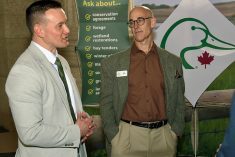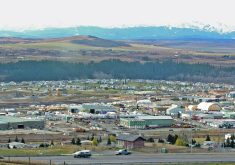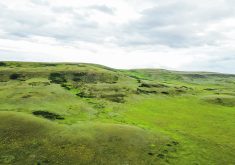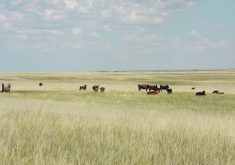White Moose Ranch offers 2,000 acres to the Nature Conservancy of Canada to connect the Sheep and Highwood rivers
Two thousand acres of land in arguably one of the most picturesque regions of Alberta became part of a conservation agreement Oct. 11 between the Nature Conservancy of Canada and landowner Stan Carscallen.
Those acres are a portion of Carscallen’s White Moose Ranch located west of Turner Valley and a 45-minute drive southwest of Calgary.
Bordered on the north by the Sheep River and on the south by the historic OH Ranch, the parcel is adjacent to other land also under easement via the NCC.
Read Also

Farming Smarter receives financial boost from Alberta government for potato research
Farming Smarter near Lethbridge got a boost to its research equipment, thanks to the Alberta government’s increase in funding for research associations.
“The moment I first saw this property I realized it was very, very special,” said Carscallen.
Given that the NCC easement on the OH extends south to the Highwood River, “by putting this conservation easement on, together with our neighbour at the OH who has done the same, we’ve created a full conserved corridor between those two rivers west of Turner Valley.”
Carscallen said the region is constantly under pressure from developers and he has been asked many times to sell the property, which he has owned since 1992. As a result of the conservation easement, the 2,000 acres in the NCC agreement will never be sub-divided and will always be owned in a single block.
The land will continue to be ranched as it has been, said Carscallen. He runs 700 Black Angus cows on about 11,000 acres, 4,000 of which he owns and the balance leased.
“We do everything on the ranch on horseback so we’re pretty gentle with the land,” he said.
Given its proximity to Kananaskis Country, the property is prime habitat for wildlife, including elk, deer, moose, black bears, grizzly bears, cougars, wolves, coyotes and eagles.
The NCC said in a news release that the Sheep River hosts bull trout and westslope cutthroat trout, both listed as threatened under the Species at Risk Act.
Although moose make a home on White Moose Ranch, they have nothing to do with the property’s name. It comes instead from a long-legged breed of cattle that used to be raised on the property, Carscallen explained.
Marchigiana cattle are light grey or white and able to leap fences when so inclined. Carscallen said his neighbour often notified him that his “white moose” had once again jumped the fence into his pasture.
The name stuck.
The 2,000 acres involved in the easement are primarily used for winter pasture on the White Moose Ranch because they have good western and southern exposure, some high hills and good shelter.
Carscallen said he is pleased that he and his wife, Eva Friesen, and his sons, Brock and Gavin Carscallen, have taken steps to conserve the land despite the resulting loss in appraised land value.
The NCC’s appraiser estimated the easement devalues the property by 58 percent, primarily due to lost opportunity from subdivision, but Carscallen said that doesn’t bother him.
“For me, I don’t care because I’m not selling, so why would I care? That’s my attitude anyway. I’m glad that we’ve done this.”
The NCC said a portion of this project was donated under the federal government’s Ecological Gifts Program, “which provides enhanced tax incentives for individuals or corporations who donate ecologically significant land.”
Bob Demulder, regional vice-president of the NCC, called the White Moose easement “a fantastic example of how working landscapes and conservation go hand in hand.”
Addition of this property to other land in the area under NCC easement has created a block approximately eight kilometres wide and 10 km long between the Highwood and Sheep rivers next to Kananaskis Country.


















